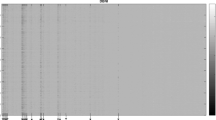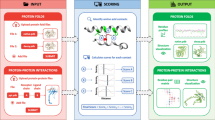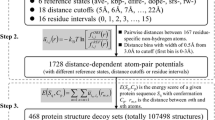Abstract
Extracting a well-designed energy function is important for protein structure evaluation. Knowledge-based potential functions are one type of the energy functions which can be obtained from known protein structures. The pairwise potential between atom types is approximated using Boltzmann’s law which relates the frequency of atom types to its potential. The total energy is approximated as a summation of pairwise potential between the atomic pairs. In the present study, the performance of knowledge-based potential function was assessed based on the strength of interaction between groups of amino acids. The dominant energies involved in the pairwise potentials were revealed by eigenvalue analysis of the matrix, the elements of which represent the energy between amino acids. For this purpose, the matrix including the mean of the energies of residue–residue interaction types was constructed using 500 native protein structures. The matrix has a dominant eigenvalue and amino acids, with LEU, VAL, ILE, PHE, TYR, ALA and TRP having high values along the dominant eigenvector. The results show that the ranking of amino acids is consistent with the power of amino acids in discriminating native structures using K-alphabet reduced model. In the reduced interactions, only amino acids from a subset of all 20 amino acids, along with their interactions are considered to assess the energy. In the K-alphabet reduced model, the reduced structures are constructed based on only the K-amino acid types. The dominant K-alphabet reduced model derived for the k-first amino acids in the list [LEU, VAL, PHE, ILE, TYR, ALA, TRP] of amino acids has the best discrimination of native structure among all possible K-alphabet reduced models. Knowledge-based potentials might be improved with a new strategy.




Similar content being viewed by others
References
Anfinsen CB (1973) Principles that govern the folding of protein chains. Science 181(4096):223–230
Anishchenko I, Kundrotas PJ, Vakser IA (2018) contact potential for structure prediction of proteins and protein complexes from Potts model. Biophys J 115(5):809–821. https://doi.org/10.1016/j.bpj.2018.07.035
Buchfink B, Xie C, Huson DH (2015) Fast and sensitive protein alignment using DIAMOND. Nat Methods 12:59. https://doi.org/10.1038/nmeth.3176 (https://www.nature.com/articles/nmeth.3176#supplementary-information)
Cremades N, Sancho J, Freire E (2006) The native-state ensemble of proteins provides clues for folding, misfolding and function. Trends Biochem Sci 31(9):494–496. https://doi.org/10.1016/j.tibs.2006.07.001
Das R, Qian B, Raman S, Vernon R, Thompson J, Bradley P, Khare S, Tyka MD, Bhat D, Chivian D, Kim DE, Sheffler WH, Malmström L, Wollacott AM, Wang C, Andre I, Baker D (2007) Structure prediction for CASP7 targets using extensive all-atom refinement with Rosetta@home. Proteins Struct Funct Bioinform 69(S8):118–128. https://doi.org/10.1002/prot.21636
Debroise T, Shakhnovich EI, Chéron N (2017) A hybrid knowledge-based and empirical scoring function for protein-ligand interaction: SMoG2016. J Chem Inf Model 57(3):584–593. https://doi.org/10.1021/acs.jcim.6b00610
Deng H, Jia Y, Zhang Y (2016) 3DRobot: automated generation of diverse and well-packed protein structure decoys. Bioinformatics 32(3):378–387. https://doi.org/10.1093/bioinformatics/btv601
Domingues FS, Koppensteiner WA, Jaritz M, Prlic A, Weichenberger C, Wiederstein M, Floeckner H, Lackner P, Sippl MJ (1999) Sustained performance of knowledge-based potentials in fold recognition. Proteins Suppl 3:112–120
Eck RV, Dayhoff MO (1966) Evolution of the structure of ferredoxin based on living relics of primitive amino acid sequences. Science 152(3720):363. https://doi.org/10.1126/science.152.3720.363
Etchebest C, Benros C, Bornot A, Camproux AC, de Brevern AG (2007) A reduced amino acid alphabet for understanding and designing protein adaptation to mutation. Eur Biophys J 36(8):1059–1069. https://doi.org/10.1007/s00249-007-0188-5
Galgonek J, Vymetal J, Jakubec D, Vondrášek J (2017) Amino acid interaction (INTAA) web server. Nucleic Acids Res 45(W1):W388–W392. https://doi.org/10.1093/nar/gkx352
Godzik A, Skolnick J, Koliński A (1995) Are proteins ideal mixtures of amino acids? Analysis of energy parameter sets. Protein Sci 4(10):2107–2117. https://doi.org/10.1002/pro.5560041016
Hamelryck T, Borg M, Paluszewski M, Paulsen J, Frellsen J, Andreetta C, Boomsma W, Bottaro S, Ferkinghoff-Borg JJPo (2010) Potentials of mean force for protein structure prediction vindicated, formalized and generalized. PLoS One 5(11):e13714
Huang JT, Wang T, Huang SR, Li X (2015) Reduced alphabet for protein folding prediction. Proteins 83(4):631–639. https://doi.org/10.1002/prot.24762
Islam MM, Sohya S, Noguchi K, Yohda M, Kuroda Y (2008) Crystal structure of an extensively simplified variant of bovine pancreatic trypsin inhibitor in which over one-third of the residues are alanines. Proc Natl Acad Sci 105(40):15334–15339. https://doi.org/10.1073/pnas.0802699105
James LC, Tawfik DS (2003) Conformational diversity and protein evolution–a 60-year-old hypothesis revisited. Trends Biochem Sci 28(7):361–368. https://doi.org/10.1016/s0968-0004(03)00135-x
John B, Sali A (2003) Comparative protein structure modeling by iterative alignment, model building and model assessment. Nucleic Acids Res 31(14):3982–3992
Kamtekar S, Schiffer JM, Xiong H, Babik JM, Hecht MH (1993) Protein design by binary patterning of polar and nonpolar amino acids. Science 262(5140):1680–1685
Keasar C, Levitt M (2003) A novel approach to decoy set generation: designing a physical energy function having local minima with native structure characteristics. J Mol Biol 329(1):159–174
López-Blanco JR, Chacón P (2019) KORP: knowledge-based 6D potential for fast protein and loop modeling. Bioinformatics. https://doi.org/10.1093/bioinformatics/btz026
Lovell SC, Davis IW, Arendall WB 3rd, de Bakker PI, Word JM, Prisant MG, Richardson JS, Richardson DC (2003) Structure validation by Calpha geometry: phi, psi and Cbeta deviation. Proteins 50(3):437–450. https://doi.org/10.1002/prot.10286
Mirzaie M (2018) Hydrophobic residues can identify native protein structures. Proteins 86(4):467–474. https://doi.org/10.1002/prot.25466
Mirzaie M, Sadeghi M (2011) Knowledge-based potentials in protein fold recognition. J Paramed Sci 1(4):63–73. https://doi.org/10.22037/jps.v1i4.2274
Mirzaie M, Sadeghi M (2012) Distance-dependent atomic knowledge-based force in protein fold recognition. Proteins 80(3):683–690. https://doi.org/10.1002/prot.24011
Mirzaie M, Sadeghi M (2014) Delaunay-based nonlocal interactions are sufficient and accurate in protein fold recognition. Proteins 82(3):415–423. https://doi.org/10.1002/prot.24407
Mirzaie M, Eslahchi C, Pezeshk H, Sadeghi M (2009) A distance-dependent atomic knowledge-based potential and force for discrimination of native structures from decoys. Proteins 77(2):454–463. https://doi.org/10.1002/prot.22457
Miyazawa S, Jernigan RL (1985) Estimation of effective interresidue contact energies from protein crystal structures quasi chemical approximation. Macromolecules 18(3):534–552. https://doi.org/10.1021/ma00145a039
Miyazawa S, Jernigan RL (1996) Residue-residue potentials with a favorable contact pair term and an unfavorable high packing density term, for simulation and threading. J Mol Biol 256(3):623–644. https://doi.org/10.1006/jmbi.1996.0114
Murphy LR, Wallqvist A, Levy RM (2000) Simplified amino acid alphabets for protein fold recognition and implications for folding. Protein Eng Des Sel 13(3):149–152. https://doi.org/10.1093/protein/13.3.149
Ovchinnikov S, Park H, Varghese N, Huang P-S, Pavlopoulos GA, Kim DE, Kamisetty H, Kyrpides NC, Baker D (2017) Protein structure determination using metagenome sequence data. Science 355(6322):294–298. https://doi.org/10.1126/science.aah4043
Park B, Levitt M (1996) Energy functions that discriminate X-ray and near-native folds from well-constructed decoys. J Mol Biol 258(2):367–392
Riddle DS, Santiago JV, Bray-Hall ST, Doshi N, Grantcharova VP, Yi Q, Baker D (1997) Functional rapidly folding proteins from simplified amino acid sequences. Nat Struct Biol 4(10):805–809
Sankar K, Jia K, Jernigan RL (2017) Knowledge-based entropies improve the identification of native protein structures. Proc Natl Acad Sci 114(11):2928–2933. https://doi.org/10.1073/pnas.1613331114
Shibue R, Sasamoto T, Shimada M, Zhang B, Yamagishi A, Akanuma S (2018) Comprehensive reduction of amino acid set in a protein suggests the importance of prebiotic amino acids for stable proteins. Sci Rep 8(1):1227. https://doi.org/10.1038/s41598-018-19561-1
Simons KT, Kooperberg C, Huang E, Baker D (1997) Assembly of protein tertiary structures from fragments with similar local sequences using simulated annealing and Bayesian scoring functions. J Mol Biol 268(1):209–225
Simons KT, Ruczinski I, Kooperberg C, Fox BA, Bystroff C, Baker D (1999) Improved recognition of native-like protein structures using a combination of sequence-dependent and sequence-independent features of proteins. Proteins Struct Funct Bioinform 34(1):82–95
Sippl MJ (1990) Calculation of conformational ensembles potentials of mean force—an approach to the knowledge-based prediction of local structures in globular proteins. J Mol Biol 213(4):859–883. https://doi.org/10.1016/s0022-2836(05)80269-4
Tang Q-Y, Zhang Y-Y, Wang J, Wang W, Chialvo DR (2017) Critical fluctuations in the native state of proteins. Phys Rev Lett 118(8):088102. https://doi.org/10.1103/PhysRevLett.118.088102
Vendruscolo M, Paci E, Dobson CM, Karplus M (2001) Three key residues form a critical contact network in a protein folding transition state. Nature 409(6820):641–645. https://doi.org/10.1038/35054591
Wang W (2016) Simplification of complexity in protein molecular systems by grouping amino acids: a view from physics AU—Wang. Adv Phys X 1(3):444–466. https://doi.org/10.1080/23746149.2016.1216329
Wang J, Wang W (1999) A computational approach to simplifying the protein folding alphabet. Nat Struct Biol 6:1033. https://doi.org/10.1038/14918
Wei G, Xi W, Nussinov R, Ma B (2016) Protein ensembles: how does nature harness thermodynamic fluctuations for life? The diverse functional roles of conformational ensembles in the cell. Chem Rev 116(11):6516–6551. https://doi.org/10.1021/acs.chemrev.5b00562
Xia Y, Huang ES, Levitt M, Samudrala R (2000) < i > Ab initio </i > construction of protein tertiary structures using a hierarchical approach. J Mol Biol 300(1):171–185
Zwanzig R, Szabo A, Bagchi B (1992) Levinthal’s paradox. Proc Natl Acad Sci 89(1):20. https://doi.org/10.1073/pnas.89.1.20
Author information
Authors and Affiliations
Corresponding author
Ethics declarations
Conflict of interest
The author declares no conflict of interest. This work was financially supported by the Iran National Science Foundation (INSF)(http://en.insf.org/) under Grant number 97003215.
Additional information
Handling Editor: S. C. E. Tosatto.
Publisher's Note
Springer Nature remains neutral with regard to jurisdictional claims in published maps and institutional affiliations.
Electronic supplementary material
Below is the link to the electronic supplementary material.
Rights and permissions
About this article
Cite this article
Mirzaie, M. Discrimination power of knowledge-based potential dictated by the dominant energies in native protein structures. Amino Acids 51, 1029–1038 (2019). https://doi.org/10.1007/s00726-019-02743-0
Received:
Accepted:
Published:
Issue Date:
DOI: https://doi.org/10.1007/s00726-019-02743-0




